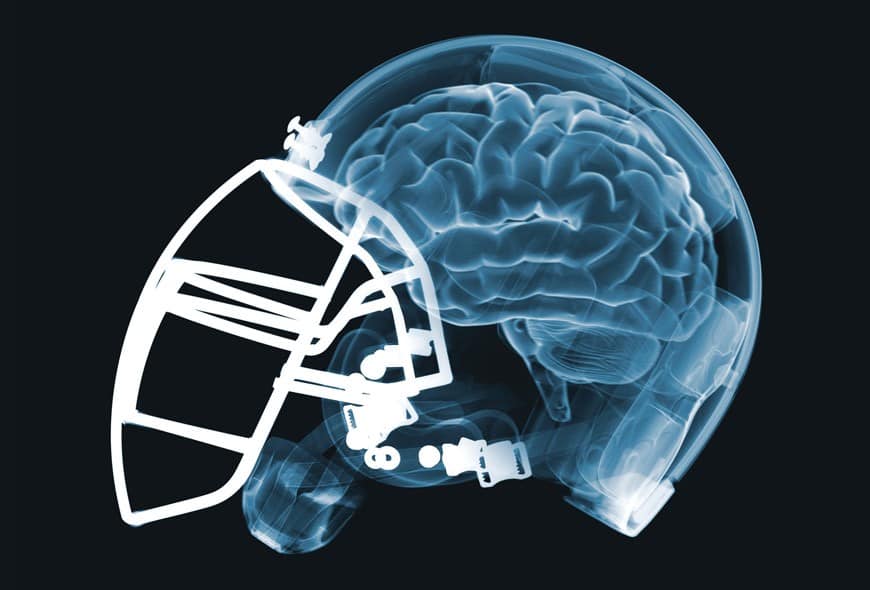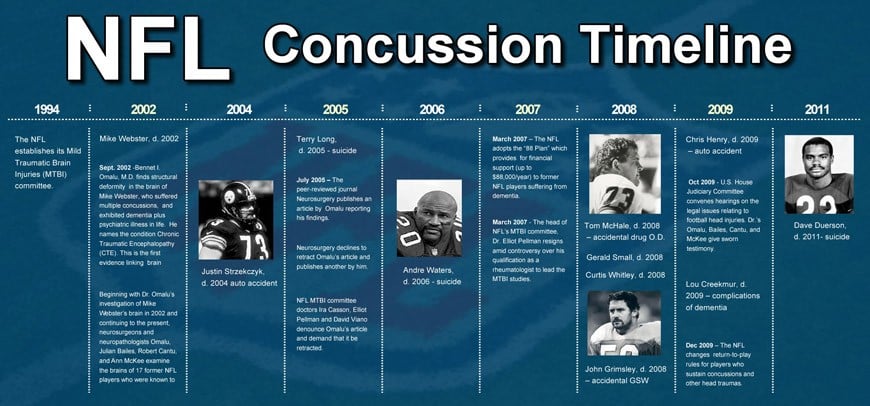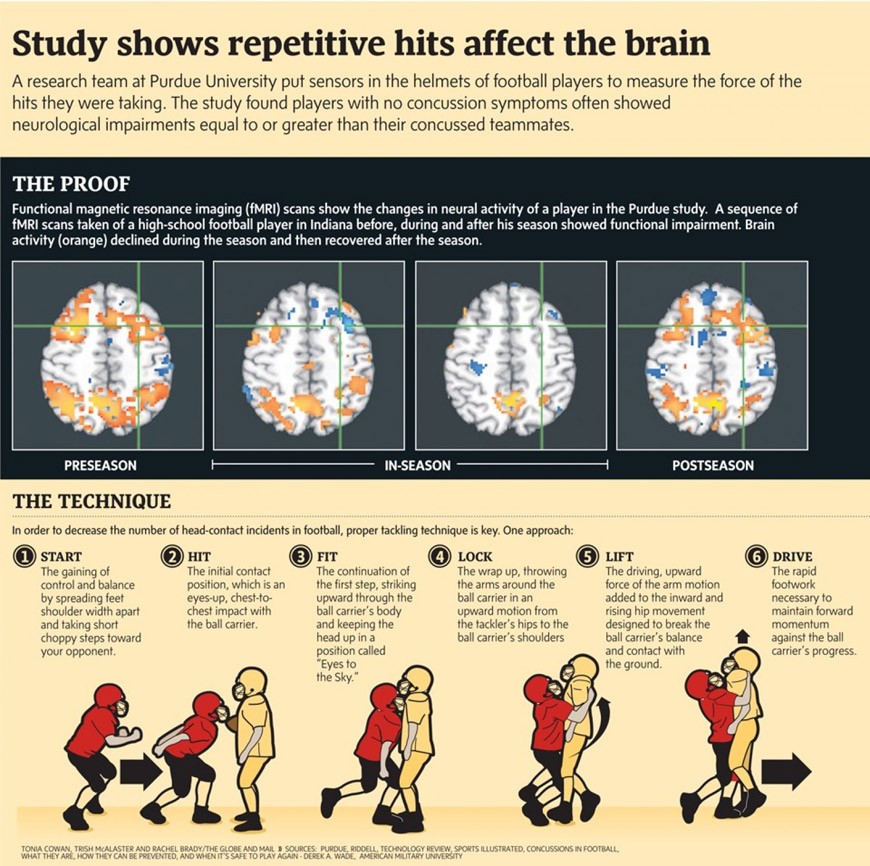Published in 2004, a research study led by Virginia Tech University engineer Stefan Duma concluded that football players are consistently struck in the head 30 to 50 times per game. In fact, compiled via sensors fitted in player helmets (similar to the sensors used to test car airbags), Duma’s recorded data demonstrated that football head injuries are similar to those experienced during a car wreck.
One need not possess an engineering degree to know that a regular dose of twisted metal is anything but ideal for the human body, nor does a person require anything more than the naked eye to believe that the force of a hit endured by a football player falls smack in the ballpark of cruel, unusual and unhealthy punishment.
Following a recent surge in National Football League (NFL) player lawsuits and a string of tragic deaths linked to performance-induced brain damage, what does research suggest athletes (current and former) need to be made aware of regarding the cumulative effects of sport-related head injuries today? And what are some examples of proactive deterrents to permanent brain damage that are now available to at-risk players?
Carnage Consequences
First recognized in 1928, the initially termed condition Dementia pugilistica refers to the dementia (progressive deterioration of intellectual functions) developed by boxers due to the suffering of unique brain degeneration following infliction of repetitive head injuries. The condition is marked by an accumulation of “tau” in the brain, which is an abnormal protein that accumulates around blood vessels, consequentially disrupting normal brain functioning and ultimately destroying nerve cells.
Today, the formally-titled dementia pugilistica condition is termed CTE (chronic traumatic encephalopathy) by the medical community and it’s an affliction that’s recently been predicted to affect one in three retired NFL players.
While various neurological disorders may result from consistent head injuries endured by athletes throughout their career (abnormal tau protein accumulation has been identified in the brain tissue of Alzheimer’s patients), CTE has clearly emerged as the most notorious among several prevalent brain damage-linked conditions suffered by former and current football players.
Following years of punishment (football players are estimated to suffer more than 8,000 hits over the course of their high school and college career alone), resultant CTE in players most commonly causes changes in mood and behavior, primarily in patients between 20 and 40 years old, and in cognitive functions as well, leading to dementia in patients between 50 and 70 years old.
Depression and bouts of rage are also symptoms of CTE, which certainly could have factored into the tragic suicide of former San Diego Charger Junior Seau as well as in the murder-suicide of former Kansas City Chief Jovan Belcher and his girlfriend, Kasandra Perkins. Seau and Belcher’s brain tissue both showed signs of CTE post-mortem. In fact, post-mortem brain research has even suggested that significant brain alterations can progress over several years in patients who’ve only suffered a single traumatic brain injury (TBI).
Although the career-spanning consistency of football head injuries is remarkably significant to the depth of a player’s cumulative brain trauma, the time (or lack thereof) spent recovering from head injuries is equally relevant to the scope of permanent neurological damage.
Neuropsychologist Dr. Marla Shapiro tells MiLLENNiAL, “Concussions are metabolic injuries. It creates an energy crisis in the brain. The idea is to allow the brain to rest and calm down before you sustain another hit. If we can get folks to rest, we can prevent long-term consequences.”
Therefore, taking precautions to prevent permanent brain damage is preferable to attempting speculative treatment after permanent damage is already done.
Defend Against Football Head Injuries
Despite a high prevalence of traumatic brain injury in football players and a shocking scarcity of preventative measures taken by athletes in the past, significant efforts to develop groundbreaking protective technology are decades into development. In 1986, the Protective Sports Equipment company (PSE) was incorporated as a means of advancing safe helmet technology for athletes. Led by CEO John George Roman, a former NFL lineman for the New York Jets, PSE (now known as Defend Your Head) was founded upon a commitment to making football a safer sport for athletes and the company conducted years of research to live up to their commitment.
The technological development of Defend Your Head (DYH) introduced the ProCap soft shell helmet technology, which allows athletic helmets an absorption of traumatic impact superior to all of its technological predecessors. Employing a specialized polyurethane foam, the ProCap cover uses minute movement technology to deflect harmful impact away from the head by enabling the cover to move slightly over the helmet beneath it.
Additionally, the ProCap material is highly absorptive, delaying the time your head suffers the impact of a hit just as an airbag delays the time of your body and head from hitting a dashboard in a car crash. Such a delay lessens the blow upon a player’s cranium. Lastly, the low coefficient of friction (COF) in the ProCap cover makes it slippery, much more so than helmets made with polycarbonate or ABS materials, allowing sideways or tangential blows (often the most dangerous hits for head trauma) to glance off the helmet quicker.
Ultimately, the prevalence of football head injuries is a cultural issue dependent upon an athlete’s education in the consequences of not taking care of the body. The two most important injury-prevention assets an athlete possesses are knowledge of injury consequences and a healthy dose of humility in attempting to prevent those consequences.
Illustrating the importance of such assets, John Roman sums up the mission of Defend Your Head by telling us, “former players such as myself can send a powerful message to players coming up. I’m always willing and able to let the guys know that it’s okay to admit you have an injury. You want to play the game as long as you can.”



